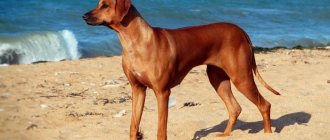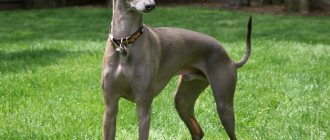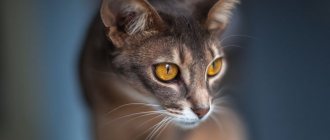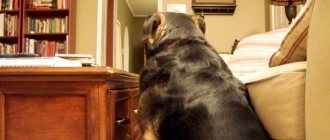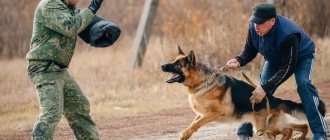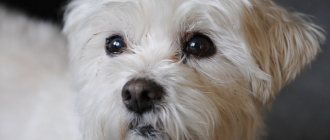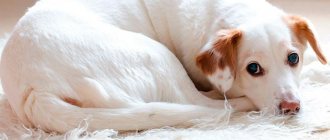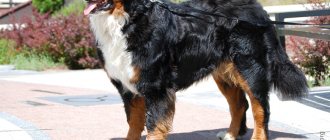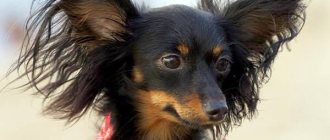History of the Russian Borzoi breed
Mentions of dogs, with which our ancestors successfully hunted not only hares, but also wolves, can be found in printed publications of the 17th century. Presumably the first and most famous breeder of greyhounds was the Russian Tsar Alexei Mikhailovich Romanov, who received several dogs of this breed as a gift from the Zaporozhye Cossacks. The version that the ancestors of today's Russian greyhounds were brought to us from Persia and the Kazakh Khanate during the time of Ivan the Terrible also has a right to life. The autocrat had great respect for hunting greyhounds and was quite sincerely interested in new hunting breeds.
Russian greyhound
Since the 18th century, the clan of greyhounds has been subjected to large-scale “pumping”. To improve the hunting qualities of dogs, they began to cross them with Hort and English, and subsequently with Crimean and mountain greyhounds. Selection activity took place spontaneously, since the main breeder of the breed remained the noble class, which kept its own kennels and had the opportunity to experiment with breeding to its heart’s content. Not limited by any boundaries, landowners bred animals, guided only by their own preferences, which ultimately led to the fragmentation of the greyhound family and slowed down the standardization of the breed. As a result, the first dog conformation standard was written only in 1888.
The breed began appearing at domestic exhibitions in 1872 and almost immediately disappointed all aesthetes who saw the animals as ordinary mestizos who had lost the classic features of the Russian greyhound. But the panel of judges at the Moscow Exhibition of the Imperial Society for Proper Hunting treated four-legged competitors more kindly and in 1874 awarded a gold medal to a Russian greyhound named Reward. But even this decision did not put an end to the desperate debate among experts about exactly what a proper Russian greyhound should look like. As a result, traditionalists continued to advocate for a return to the original type of appearance of the dogs, while the other half of the breeders stubbornly voted for the updated appearance of the greyhounds.
Since the beginning of the 20th century, the breeding of Russian greyhounds was carried out at an accelerated pace, and by 1917 the number of purebred individuals in Russia exceeded 2000. Of course, during the years of the Civil War and the Great Patriotic War, the clan of Russian greyhounds suffered significant losses, but nevertheless did not cease to exist , which made it possible for Soviet enthusiasts to once again start breeding these amazing animals. The breed came to America and Canada at the beginning of the 20th century, after Europe had had plenty of fun with the grace and hunting talents of its representatives and even managed to cool down a little towards them. By the way, it was on the other side of the Atlantic that Russian greyhounds gained the greatest popularity, where they were accepted not as hunters, but as sports, image pets.
How to care for a Horta Greyhound?
Dogs of this breed are not demanding in care. Since they have almost no undercoat, you can use a brush or mitten for combing, without any separate devices. After a walk, a thorough inspection of your pet’s fur is required to check for ticks and fleas. If the dog lives in an apartment, then after a walk it is necessary to wash its paws. There is no need for frequent bathing - for a Horta greyhound, a complete wash 1-2 times a year is enough.
We advise you to read: Dog Breed Jack Russell Terrier
Nail trimming is not required, especially if the dog often runs on hard surfaces. But from the very beginning it is worth teaching the puppy to brush his teeth, since their health is valued not only in specimens going to the exhibition, but teeth also represent an important working tool for this breed.
Appearance of the Russian Borzoi
Russian Greyhound Puppy
Russian Greyhounds are the epitome of sophistication and elegance. Among their peers, these lean, ascetic beauties stand out for their refined appearance and mesmerizing ease of movement. Despite their fairly high height (males - up to 85 cm at the withers, females - up to 78 cm), Russian greyhounds do not give the impression of heavyweight giants. At one time, this feature of the breed was very subtly played up by the genius of the Art Nouveau era, Louis Icarus. As soon as the artist depicted the elongated, proud silhouette of the Russian greyhound in his paintings a couple of times, it became a fashion trend, and illustrations, engravings and even sculptures glorifying the regal bearing of greyhounds fell on French and Russian fans of the breed as if from a cornucopia.
Head
The skull of the model Russian Borzoi has an elongated shape, which is why the dog's head appears very narrow. The occipital protuberance of representatives of this breed is quite pronounced, and the stop line is noticeably smoothed.
Teeth and bite
Hi, neighbor!
The teeth of the Russian Borzoi are strong and white. The bite can be straight or scissor.
Nose
The bridge of the nose is long, with a slightly noticeable hump. The lobe is large, mobile, protruding forward.
Eyes
The Russian Borzoi has beautiful expressive eyes: almond-shaped, slightly convex, rich brown color.
Ears
The ears of the Russian Borzoi are miniature, thin, set slightly above eye level. The ear flap is noticeably drawn towards the back of the head, and its tips are pressed tightly against the neck. In an excited or alert dog, the ears become erect.
Neck
The neck of the Russian Borzoi is dry, quite long and muscular. On the sides, the muscles are slightly flattened, which is why the neck looks flattened.
Muzzle of a Russian greyhound
Frame
Thanks to the muscular back and massive, sloping croup, the topline forms a long arc, which is more pronounced in males. The chest of Russian greyhounds is deep, oval in shape, less than or equal in width to the croup. The abdominal area is well toned: the bottom line is steep, with a so-called tuck.
Legs
Running Russian greyhound
The front legs of the Russian Greyhound are dry and well muscled. The shoulder blades are long, sloping, the elbows are normal, looking back. The hind limbs of the RPB are set wider than the front ones. The thighs are elongated, moderately muscled, the hock joints are wide, well developed, with normal angles. The paws of representatives of this breed are narrow, arched, and hare-like. The Russian greyhound moves in everyday life at a light trot, and when hunting - with sweeping jumps (fast trot).
Tail
Crescent-shaped, long and thin, with a lush dewlap. The calm Russian Greyhound has a tail that hangs down. If the dog is excited, the tail can rise, but not higher than the level of the back.
Wool
Russian greyhounds at an exhibition
The dog's body is covered with long, wavy or slightly curly hair. On the ears, head and front of the legs the hair is very short and silky. On the animal’s neck there is a lush pendant made of dog clothes, and the back of the thighs is decorated with cute “pants.” In the area of the croup and shoulder blades the curl of the coat is steeper.
Color
All types of spotted and piebald colors are assigned to Russian greyhounds, with the exception of blue and chocolate tones. The dewlaps on the dog's neck and tail, as well as the fur on its thighs, are usually lighter than the rest of the body. A distinctive feature of dark-colored individuals is a muzzle with a so-called mazurina (black mask).
Defects and disqualifying defects
Depending on the severity, defects in appearance can be either minor or serious. And if, for example, a Russian greyhound never receives the highest score for its coarse coat or lightweight constitution, then for aggression and an asymmetrical bite it risks not being allowed to participate in competitions at all. Most often, the exhibition commission rejects Russian greyhounds for fundamental differences with the breed standard, for example, for the blue color of the iris, the absence of one of the teeth, a blue or brown shade of the coat, as well as for the presence of dewclaws. Incorrect position of the fangs, which damages the soft tissues of the oral cavity, also leads to complete disqualification.
Description of the Hortaya Greyhound breed and characteristics
In many ways, the appearance of the Horta Greyhound is similar to the standard exterior of greyhounds. It is characterized by a strong, moderately narrow body. Height of males – 65-75 cm and above, females – 61-71 cm, weight of males – 25-35 kg, females – 18-25 kg. The head, in proportion to the body, is not large; on the skull there is a pronounced bump on the back of the head, called the “falcon”. The muzzle is narrowed and dry. The forehead is slightly sloping, neatly transitioning into a slanted nose, on which a slightly noticeable hump is allowed. The pigmentation of the nasal lobe is dark.
There is a scissor bite. The eyes are slanted, large, and their irises are characterized by different shades of brown. The ears are small and stand low, their shells are thin, and the ears themselves are located along the neck. Even if the dog is alert, their soft tips are thrown to the side or forward. The muscles on the long neck are clearly visible, but the neck itself is slightly compressed on the sides.
A strong, elongated body, a deep chest, quite spacious, oval in shape. The ribs protrude slightly, immediately behind the elbow joint, forming a barrel-shaped increase, sloping towards the abdomen. On a strong back there is a clearly visible wither, gradually lowering, turning into a hollow.
A slight convexity on the wide loin decreases closer to the tail. According to the rules, the tail lowered down is quite long, the tip is curled into a half ring. In most cases, there is no dewlap or fringe on it (or is barely pronounced). The belly is carefully selected. The limbs are long and parallel, the joints are well defined. The forearm is longer than the shoulder, and the lower leg is longer than the thigh. The hind legs stand wide and slightly pulled back. On the front legs the shape of the foot is round, and on the hind legs it is closer to oval. The feet themselves are arched, slightly compressed on the sides.
We advise you to read: English Setter Dog Breed
Although the Horta Greyhound has many features that make it similar to Greyhounds, their muscle groups are distributed and developed differently. There are also differences in the structure of the skull, especially the muzzle. This muscular structure affects the speed abilities of short greyhounds, allowing them to easily overtake even fast saigas reaching speeds of up to 90 km/h. In addition, these dogs have simply extraordinary endurance. They tirelessly chase prey throughout the daylight hours. With a commercial hunt lasting up to 3-4 weeks, greyhounds work through a full season without failure. Thanks to the streamlined body shape and lightness of the skeleton, greyhounds can reach even higher speeds than hounds. To change the balance of the body in the process of rapid movement, the dog only needs to tilt its long neck.
In an article about this breed, K.M. Esmont called their paws “iron”, because they allow the dog to fly headlong across the frozen ground without slowing down. The persistence and agility of the Horta Greyhound allows it to give a head start to a dog of any other breed - it only needs one lightning-fast throw to overtake its prey. Due to their keen vision and instant reaction, short greyhounds can distinguish prey at a fairly impressive distance of several kilometers. A wide field of vision is provided by the elongated shape of the muzzle.
As if compensation for all the phenomenal abilities, the sense of smell in dogs of the Hortai breed is not the sharpest. But the most valuable qualities in the breed have always been lightning speed of reaction, visual acuity and attentiveness.
There are a number of minor differences between the greyhound varieties of the north and south. For example, Stavropol greyhounds are more graceful, with light bones, short dewlap on the tail and hind legs, and almost no undercoat. Greyhounds from Rostov are distinguished by rough bones, high stature and slightly longer coats with a characteristic undercoat. However, all differences do not go beyond breed standards.
Photo of a Russian greyhound
Character of the Russian Borzoi
Russian greyhounds are real geniuses of transformation. When hunting, they are unstoppable and passionate, but as soon as the animals find themselves within the walls of their home, the melancholy quiet ones immediately awaken within them. In general, Russian greyhounds are one of the most convenient pets: they are “little talkative” and do not follow their owner’s tail to get their share of attention. The Russian greyhound prefers to spend its time free from hunting and walking in a passive manner, resting on the sofa or nestling at the feet of the owner. The breed is also not capable of all sorts of unpleasant surprises, such as torn wallpaper and holey shoes, provided, of course, that the dog is walked regularly.
Russian greyhound with his owner
The Russian Greyhound doesn’t feel much love for children, but it doesn’t harbor much hostility either. What irritates her most is sudden screams and laughter, so when noisy children's groups come to the owner's home, the dog, as a rule, tries to retreat. Due to their peaceful nature and innate delicacy, Russian greyhounds are moderately polite in communication, including with strangers, but in return they demand exactly the same attitude towards themselves. Possessing a very vulnerable psyche, the Russian greyhound is extremely sensitive to any injustice, so punishment for this breed is a real tragedy.
Increased excitability is another distinctive character trait of Russian greyhounds. Just now your pet was strolling imposingly at your feet, but then a random catfly loomed on the horizon, and your phlegmatic dog seemed to be blown away by the wind. The reason for such a sharp transition from one state to another is the pursuit instinct, which in this breed has evolved to the level of mania.
The intellectual indicators of the Russian greyhound are quite good, although inexperienced owners may initially encounter difficulties in raising and training their pets. It is important to understand here that the Russian Greyhound is not a companion or a service dog, but a professional hunter whose main goal is to work with game. Accordingly, all the intelligence and ingenuity of the breed goes into the process of baiting the animal. At the same time, in ordinary life, a dog’s brain works in energy saving mode, which is sometimes mistakenly regarded as stupidity.
Russian greyhounds with a child
Fight
What to feed a Russian greyhound
It is necessary to remember that the Russian greyhound most of all prefers food of non-animal origin. The food must contain: mineral salts, proteins, healthy carbohydrates, vitamins, fats.
Under no circumstances should you give your dog any kind of sweets ; this is very harmful for him. As a reward, you can give her a regular cracker.
Experts recommend feeding puppies at strictly defined times . Thanks to this simple technique, the animal will always remain cheerful and energetic. Food must be warm. To avoid problems, the bowl should be placed at chest level.
In order for the puppy to grow well, he needs to be given vegetables and fruits . They contain all the necessary minerals and vitamins. After the puppy has reached the age of 4 months, it is necessary to add a variety of supplements to its main diet.
It is recommended to feed both puppies and adult dogs small portions several times a day.
Education and training
Despite the fact that the majority of Russian greyhounds are supple and obedient dogs, they do not make the most diligent students. By the way, experienced hunters are of the opinion that enrolling representatives of the breed in the OKD (General Training Course) will only spoil their natural talents. With a Russian greyhound you always need to keep your finger on the pulse: one random cry or a sharp threatening movement towards the dog - and she immediately regards this as an attempt to humiliate its dignity. So you should behave respectfully during lessons with these “aristocrats”. Moreover, the Russian greyhound is one of those breeds whose representatives have a pronounced individuality, so the program and style of training for each individual individual can vary dramatically.
Russian greyhound training
The first and most important skill that an owner must develop in his pet is the ability to clearly distinguish between hunting and ordinary life. Gently wean your puppy from chasing everything that moves during walks - the command “Near!” to help. Never let him off the leash if there are smaller four-legged creatures nearby. Trying to raise a Russian greyhound to become a domestic servant and a circus performer is also not worth it. Despite their gentle nature, greyhounds will not bring slippers and walk on their hind legs.
You will have to forget about monotonous training with this breed, since monotony for the Russian greyhound is the worst of evils. Guide your dog seriously, but not forcefully, rewarding success with treats. By 6 months, the puppy should have learned basic obedience commands (“Come to me!”, “Near!”) and be able to walk on a leash. The time period from 6 to 10 months is considered the period of teenage rebellion. A mature dog tries to assert his own authority, ignoring prohibitions in every possible way. During this period of time, it is better to be patient and restrain yourself as much as possible when the desire arises to give the shaggy lawless man a good beating in the loins.
It is better to combat teenage leadership in Russian greyhounds with additional physical activity. Moreover, the more work and training you put on a presumptuous puppy, the less time he will have for petty dirty tricks. The easiest way in this regard is for owners who, in addition to the puppy, already have an adult Russian greyhound at home. An experienced dog will quickly put a teenager who is stunned from an overabundance of energy in his place, becoming an example and senior mentor for him.
Russian greyhounds with a girl in a red dress
Dog appearance (standards)
Dimensions
Representatives of the breed are quite tall: the height of males ranges from 75 to 85 cm, females - from 68 to 78 cm. Males weigh on average 35-47 kg, females usually do not weigh more than 40 kg.
Wool
The animal has thick, long hair that is soft and silky to the touch. The fur is longer on the body and back of the thighs, where cute “pants” are formed. The muzzle and front part of the limbs are covered with shorter hair.
Photo: https://www.flickr.com/photos/ferlinka/2138835050/
The coat can be wavy and curly.
Colors
Hound colors can vary. The most common are burmat (dark fawn), sex, gray, red, black. Dogs are spotted and piebald. A feature of dark colors is the darkening of the muzzle.
The Russian greyhound can also have a white color, which is considered very rare.
Head
The greyhound's head has an elongated, elongated shape and appears very narrow.
Teeth and jaws
The dog's teeth are very strong and white. Both direct and scissor bites are allowed.
Eyes
Russian greyhounds have beautiful eyes, which are characterized by a friendly and curious expression. Eye color is brown, shape is almond-shaped.
Body and limbs
The body of dogs is long and very strong. The limbs are dry, strong and slender, set straight.
Tail
The tail is crescent-shaped. Long and thin, it hangs down when the dog is calm. In moments of excitement, elevated.
Rock defects
Defects include:
- rough or tousled fur;
- malocclusion;
- lack of teeth;
- light eye color;
- poorly developed muscles;
- coarseness;
- aggressiveness.
Hunting with a Russian greyhound
Hunting with a Russian Borzoi
The Russian greyhound is an excellent hunter in the middle zone, with which you can hunt hares and foxes, as well as a wolf, with equal success. And the point here is not only in natural instincts and innate intelligence, but also in a special, linear set of paws, which allows the dog to sharply change the direction of movement, thereby ensuring lightning-fast capture of game. However, despite such obvious advantages of the breed, today's hunters often reject its representatives as pets of low production. The reason for this neglect lies in the fact that Russian greyhounds are often crossed with other hunting dogs, as a result of which the pursuit instinct in the offspring does not manifest itself clearly enough. In addition, not all owners understand that although hunting with a Russian greyhound is a seasonal affair, they will have to develop and hone their pet’s skills and abilities throughout their life. A dog that goes out for baiting twice a year and spends the rest of the time lying on the couch will definitely not overwhelm its owner with hunting trophies.
Russian greyhounds are short-distance runners. The optimal conditions for demonstrating the hunting talents of the breed are a treeless area up to 500 m long, although, as practice shows, for most animals a 200-300-meter acceleration is enough to catch the prey and present it to the owner. The innate impulsiveness of dogs also plays an important role in the success of the hunt: upon seeing an animal, the Russian greyhound switches from standby mode to race mode in a split second. If attempts to overtake the prey are unsuccessful, the dogs are able to repeat the failed forced march after a half-hour pause.
Russian greyhounds run after a hare
Preparing for the first hunt can be considered the training of a Russian greyhound to a pack collar. You can start lessons from the age of 6 months: the puppy must learn to walk in a group, without rushing ahead or trailing behind the pack. You can hunt a Russian greyhound for game as early as 10-12 months, but at first the animals are allowed to make no more than one pursuit attempt. Teenagers are not yet as hardy as individuals who have previously participated in hunting, and are easily overtired. It would be great if the owner took two puppies into the house at once, and it is not at all necessary that both were of the same breed. As they grow up and compete for the role of alpha male, they will try harder to prove themselves during training.
It is best to bait a teenager with a Russian greyhound against a wolf in the company of experienced dogs and their owners. But you can hunt a hare alone, and in general it is more advisable to start training young greyhounds to chase game with the “eared brethren”. Often during the first hunt, greyhounds cannot restrain themselves and tear a small animal into pieces, or even eat it before the owner arrives. This, of course, is not a reason to be upset, but it is still worth slightly reproaching your pet for such behavior. Moreover, if your student demonstrates such “success” in field tests, he will not receive a diploma.
Wolf hunting with a Russian greyhound. Artist Evgeny Aleksandrovich Tikhmenev (1869–1934)
Description of the breed
The discreet beauty of the Horta Greyhound attracts with its harmony; the character of this dog evokes respect, and its intelligence and charm are beyond all measure.
The appearance of the Horta Greyhound is in many ways similar to the typical exterior of greyhounds
Appearance
Despite the small number of breed livestock, there are geographically established differences in appearance in the population. Horts of southern origin are slightly smaller and more refined than their northern “sisters”, which have more massive bones and longer, thicker coats.
Table: main features of the Horta Greyhound’s exterior according to the RKF standard
| Main articles | Description |
| Dimensions |
|
| Addition |
|
| Head |
|
| Limbs |
|
| Tail |
|
| Wool |
|
| Colors |
|
The footage of the Horty running is something beyond fantasy!
The dogs move very gracefully, at a light, sweeping trot, but when chasing game, they move into a fast-moving quarry and can reach speeds of up to ninety kilometers per hour!
Photo gallery: some color options for the Horta Greyhound
A dark saddle and part of the muzzle on a white background is considered the preferred color in some nurseries
Bright red (red) color looks impressive
Various variants of tan colors are often seen lately.
Shades of sexual (fawn) color - the most common and popular
Brown and tan color is the latest fashion trend in the breed
The red and white color looks very elegant
Murugy color is characterized by the presence of a black “patina” on a red background
The white chest and “socks” make the standard black color unusually elegant
The chubby color resembles marble - there are dark “veins” along the main background
Character and behavior
A calm, undemanding, unobtrusive and modest dog in everyday life is instantly transformed on the hunt - it is amazingly passionate, resilient and tireless in achieving its living goal. Constant contact with people and horses (horts are still often used in horse hunting) determines the complete absence of aggression as a mandatory requirement for the breed.
Horse hunting with horts is an exciting and gambling event
A smooth-haired greyhound living in a family tries very hard to be loyal to domestic animals, but sometimes cannot deny itself the pleasure of chasing cats - a hunting instinct, you know...
For Horts, communication with the owner, his praise and approval are important. Even if animals do not live in a house, but in enclosures, do not deprive them of your attention and affection. But the dog is absolutely indifferent to children - he will never offend them, but he will not play.
The Shorthaired Greyhound feels good both in the enclosure and on the sofa; she is self-sufficient, smart and independent
Disqualities and disadvantages
The main behavioral deviations, the presence of which disqualifies a dog for exhibition and removes it from breeding, are cowardice or, conversely, aggressiveness. As for the exterior, here the standard allows for various breed types, but strictly regulates the main characteristics of the breed as a whole. For a disqualification, one defect from the following list is sufficient:
- lack of teeth;
- any bite except scissors;
- eye colors other than black or dark brown;
- tail twisted in the shape of a corkscrew;
- isabella color six or other colors not provided for in the standard;
- guard hair shorter than undercoat;
- presence of dewclaws on the hind legs.
Breeding dogs should not have any defects in conformation
Maintenance and care
Russian greyhounds are not demanding of space, which makes it possible to keep them in a city apartment (with a sufficient amount of physical activity). True, we should not forget that representatives of this breed have extremely disrespect for ordinary beds and are unlikely to be content with a modest corner in the hallway. Most of all, Russian greyhounds love to lie on the sofa or the master's bed, and you should not be angry with them for this. In this way, dogs relax, trying to rest their backs and strained muscles. Some experts even advise giving the animal a separate sofa with an orthopedic mattress, if living space allows. As for yard animals, it is worth building a spacious enclosure for them and installing a booth in it with a height of at least 1 m and an area of about 1.5 m² with insulated walls and floor. If you have two greyhounds living in your house, the internal area of the booth will have to be expanded to 2.5 m².
Hygiene
The thin coat of Russian greyhounds is practically devoid of undercoat, but often becomes matted. However, dogs manage to keep their coat clean on their own. The owner only has to comb the animal a couple of times a week, and after walks, pick out any specks tangled in its fur. During the molting period, the same manipulations will have to be performed daily, which is generally a common occurrence for dogs of any breed.
Sometimes you need to look at life from a different angle
On the issue of bathing frequency, Russian greyhound breeders have not come to a consensus. As a result, some dog lovers recommend washing the Russian Greyhound once every three months, while others advise completely abandoning this activity and spending bath days only in the most urgent cases, for example, when the animal is dirty in liquid mud. The dog's eyes and ears do not require special care. Just keep them clean by removing wax from the ear cup and wiping dirt that has accumulated in the corners of the eyes with a damp piece of cloth.
The claws on the paws of Russian greyhounds should be trimmed so that they do not interfere with the animal while running. The hair between the toes is also trimmed, which gets dirty very quickly and can become a place for bacteria to accumulate, causing skin infections. In addition, greyhounds living in apartments will have to wash their paws after every walk. Moreover, in winter it is also impossible to evade this procedure - the reagents that are sprinkled on roads in our country are extremely poisonous and can cause poisoning in a dog when it suddenly decides to lick its own paw.
Walk
Walking a Russian greyhound on a bicycle
If you just can’t motivate yourself to go for morning and evening runs, then the Russian Greyhound is your dog. No matter how passively representatives of this breed behave at home, it is not in their rules to walk sedately along sidewalks and park paths, which means that while walking your pet you will also have the opportunity to properly warm up. If walking doesn’t inspire you, tie a leash with your greyhound to a bicycle and pedal as hard as you can: Russian greyhounds also greatly respect such errands. By the way, it is necessary to go outside with a Russian greyhound in any weather, so you won’t be able to avoid the promenades in the drizzling rain.
It’s great if you have the opportunity to periodically take your pet out into nature, where he can give free rein to his own hunting instincts. In a city environment, such a trick will not work, so walk your dog strictly on a leash if you do not want a pet that is interested in a stray cat to leave you forever, because Russian greyhounds, carried away by the chase, simply do not hear the owner’s commands and shouts. In addition, dogs that are not used to hunt will have to find an interesting alternative hobby. This could be, for example, coursing (chasing a mechanical “hare”) or simple entertainment like running after a ball and frisbee.
Feeding
In the case of Russian greyhounds, experts advise adhering to the principles of fractional feeding. Representatives of this breed are fed 3-4 times a day, dividing the daily diet into small portions. Dry food for greyhounds is also not contraindicated, unless it is a budget option from the nearest supermarket. The basis of the diet of a Russian greyhound that eats natural food should be lean raw meat. Breeders consider horse meat to be the ideal variety, since it is extremely rarely infected with brucellosis. The dog menu also includes low-fat sea fish of the cod family, which, if desired and if you have free finances, can easily be replaced with squid meat.
Walking with greyhounds in a snowy forest
Buckwheat, oatmeal and rice are suitable cereals for the breed. By the way, it is better to prepare porridge from them using the brewing method, pouring boiling broth or milk over the cereals and leaving them to swell for half an hour. Vegetables are given to Russian greyhounds boiled or simply added to soup. It is also impossible to overdo it with fermented milk products, so pamper your four-legged friend with kefir or fermented baked milk more often.
For the normal growth and development of the Russian Greyhound, the correct balance of proteins and calcium is very important. For this reason, from 4 months, when puppies begin to change their teeth, mineral supplements are introduced into their menu. In addition, up to six months, dogs are given calcined cottage cheese and a chicken egg several times a week. But you should be careful with pharmaceutical calcium-containing preparations, since an excess of this macroelement is no less harmful for a puppy’s body than its deficiency.
Prohibited products:
- any food from the master's table;
- legumes;
- potatoes and other vegetables with a high starch content;
- sweets;
- fatty meat and lard;
- tubular bones;
- River fish.
Russian greyhounds are usually fed after a walk, putting a sufficient amount of food in a bowl. The dog should not chase the bowl around the apartment, licking it clean.
Coat type and color
The Short Greyhounds have a smooth coat that lies tightly on the body. It is characterized by straight hairs, without kinks, elastic, up to 2.5 cm long. The weak undercoat is almost absent in the warm season.
The color can be zonal or solid. To describe the color of the Shorthound, special terms were even introduced. In particular, the colors of these dogs come in the following types: gray and fawn (various shades), forelock, murugi, black and white with fawns, and there are also a number of colors with the so-called mazurina - the presence of an obligatory dark shade of the mask on the face and the tips of the paws in general fawn, gray or red color.
We advise you to read: Affenpinscher dog breed
For the colors of this breed, the All-Russian Pedigree and Stud Book not only used special terms to describe the shade, but also indicated its location. This is how the names appeared: forelock white-breasted, white half-eared, black and piebald with forelock tan and others.
There are not very prominent spots on the coat, which are in harmony with the base color. When the color is solid, then, as a rule, the upper part of the body is darker in comparison with the limbs and belly.
Health and disease of the Russian greyhound
The Russian Greyhound is a relatively healthy breed, but is very sensitive to all types of anesthetics. In addition, many individuals are allergic to flea and tick medications, so it is important to select such medications especially carefully. As for genetic predisposition to specific diseases, Russian greyhounds most often suffer from volvulus, bloating, retinopathy (damage to the retina), cataracts and Wobbler syndrome (compression of the spinal cord in the cervical spine).
How to choose a puppy
- Choose February or March litters, the babies of which will be ready to move to a new home in May-June. In this case, you can diversify your pet’s diet with seasonal fruits and vegetables that contain most of the vitamins necessary for a growing body.
- Don't get hung up on a specific type of appearance of your future pet (for example, the owner breeds white dogs, but you want a gray one). The Russian Greyhound is one of the most diverse breeds, and each of its representatives is beautiful in its own way.
- If you hope to raise your puppy into a professional hunter in the foreseeable future, ask whether his parents have field diplomas. You shouldn’t delude yourself too much about hereditary talents either, since hunting skills are not always passed on from parents to children and largely depend on proper training.
- The appearance of a growing Russian Greyhound puppy is constantly changing, so choosing the most spectacular baby from the litter is unlikely to be possible. However, it is still worth visually assessing the correctness of the bite, the cleanliness of the dog’s meat and the general condition of the future pet.
Origin story
The Hortai greyhound originates from the ancient Asian fold-eared greyhounds, and therefore belongs to the group of eastern greyhounds. This is one of the oldest commercial breeds bred in the south of Russia.
In the 17th century, “hortja” was the name given to a greyhound-like dog in the general sense. The term “horti” was first applied to smooth-haired greyhounds when describing the dogs at Anna Ioannovna’s kennel. As a separate breed, the Hortai Greyhound was described in 1859 by P.M. Machevarianov. The formation of the breed was significantly influenced by the Mountain and Crimean greyhounds, to a lesser extent by the Russian hound, and, according to some data, by some European greyhounds. The first official standard was adopted in the USSR in 1951.
Purpose
The Hortai Greyhound is used for unarmed hunting of foxes, hares, small ungulates, and very rarely wolves. The dog is almost universal, very playful, hardy, and has a high catching ability. Nowadays, greyhounds also participate in racing and coursing competitions.
Photos of Russian greyhound puppies
How much does a Russian greyhound cost?
If you want to become the owner of a show-class Russian greyhound puppy, get ready to spend from 40,000 to 60,000 rubles on it. Future hunters of hares and foxes from parents with hunting diplomas will cost 20,000 - 30,000 rubles. Since most dog breeders continue to believe that the first litter of Russian greyhounds is not always successful, there is a chance to save a lot on this cliché. Thus, many breeders sell the offspring of a female who has given birth for the first time at a reduced price (from 15,000 rubles), which they notify potential buyers about in advance.

